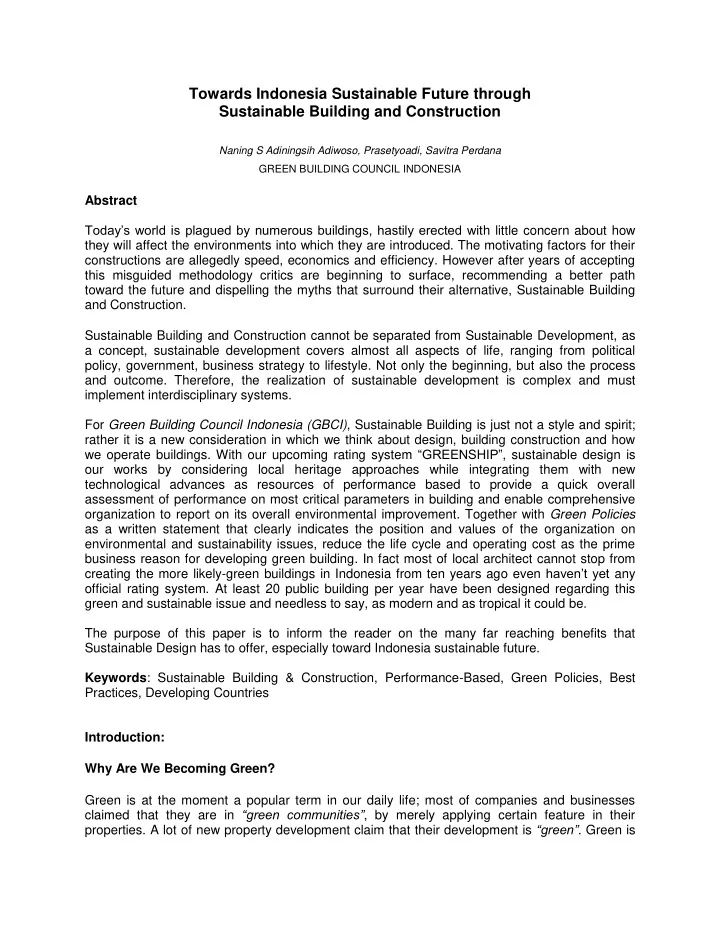

Towards Indonesia Sustainable Future through Sustainable Building and Construction Naning S Adiningsih Adiwoso, Prasetyoadi, Savitra Perdana GREEN BUILDING COUNCIL INDONESIA Abstract Today’s world is plagued by numerous buildings, hastily erected wit h little concern about how they will affect the environments into which they are introduced. The motivating factors for their constructions are allegedly speed, economics and efficiency. However after years of accepting this misguided methodology critics are beginning to surface, recommending a better path toward the future and dispelling the myths that surround their alternative, Sustainable Building and Construction. Sustainable Building and Construction cannot be separated from Sustainable Development, as a concept, sustainable development covers almost all aspects of life, ranging from political policy, government, business strategy to lifestyle. Not only the beginning, but also the process and outcome. Therefore, the realization of sustainable development is complex and must implement interdisciplinary systems. For Green Building Council Indonesia (GBCI) , Sustainable Building is just not a style and spirit; rather it is a new consideration in which we think about design, building construction and how we operate buildings. With our upcoming rating system “GREENSHIP” , sustainable design is our works by considering local heritage approaches while integrating them with new technological advances as resources of performance based to provide a quick overall assessment of performance on most critical parameters in building and enable comprehensive organization to report on its overall environmental improvement. Together with Green Policies as a written statement that clearly indicates the position and values of the organization on environmental and sustainability issues, reduce the life cycle and operating cost as the prime business reason for developing green building. In fact most of local architect cannot stop from creating the more likely-green buildings in Indonesia from ten years ago even haven’t yet any official rating system. At least 20 public building per year have been designed regarding this green and sustainable issue and needless to say, as modern and as tropical it could be. The purpose of this paper is to inform the reader on the many far reaching benefits that Sustainable Design has to offer, especially toward Indonesia sustainable future. Keywords : Sustainable Building & Construction, Performance-Based, Green Policies, Best Practices, Developing Countries Introduction: Why Are We Becoming Green? Green is at the moment a popular term in our daily life; most of companies and businesses claimed that they are in “green communities” , by merely applying certain feature in their properties. A lot of new property development claim that their development is “green” . Green is
becoming a new trend nowadays. Some Indonesian architects and engineers have been designing and applying the green principles in the design and achieve what supposed to be a green building standard. It is not merely a trend, it has to be a lifestyle change, the demand of the consumer of a “green” living environment meets the planet current conditions, climate change and degrading environmental conditions. It is important that Indonesia starting to establish a Green Building Council. “Green” has become the shorthand term for the concept of sustainable development as applied to the building industry. Green buildings, also known as high-performance buildings, are intended to be environmentally responsible, economically profitable, and healthy places to live and work. The environmental impact of the building design, construction and operation industry is significant. Buildings annually consume significant amount of energy, electricity, water and produce waste. Development shifts land usage away from natural, biologically-diverse habitats to hard-space that is impervious and devoid of biodiversity. The far reaching influence of the built environment necessitates the action to reduce its impact. Green building practice can significantly reduce or eliminate negative environmental impacts and improve existing unsustainable design, construction and operation practices. As an added benefit, green design measures reduce operating cost, enhance building marketability, increase worker productivity, and reduce potential liability from indoor air quality problems. In other words, green design has environmental, economic and social elements that benefit all building stakeholders, including owners, owners, occupant and general public. Green Building Council Indonesia; Promoting Sustainable Building Concept in The Archipelago In Indonesia, the national development performance targets for Sustainable Buildings developed by Green Building Council Indonesia (GBCI), a non-for-profit organization with a mission to support, promote and maintain the goal of market transformation, changing industry and public behavior, creating a forum and dialogue, build community and expertise in building and environmentally friendly construction. They legally authorized and cooperated with the Ministry of Environments (KLH) which do the research activities with all aspect of management of natural resources, conduct the environmental impact assessment, environmental management and laws, conservation of coastal beaches and waters, control pollution, waste treatment technology, environmental health and another. For supporting the targets, recently they authorized the criteria and green building certification. The government should encourage and facilitate initiative of the stakeholders in implementing mitigation and adaptation climate change through the management-friendly building environment. The perceived barriers of this government agency is still biased in laws and regulations which are made of green building regulations to serve as guidelines in building the future, because the legislation base of less powerful in determining the domain of green building terms. Their understanding was often separated from “Green Building” in it s implementation, while another one has a close relationship to answer the challenges faced. On the other hand, in recent years the Ministry of Environment (KLH) seeks to promote Sustainable City as a place of establishment of Sustainable Building, through “Program Bangun Praja” which aims to improve performance in environmental management, and better encourage other regions outside the capital to join apply with fixed focus in creating Sustainable City in its infancy, covering up the management of the building footing and green open space (including shade), the management of public facilities, pollution control and waste water . The second government agency involved to determine the performance target was The Ministry of Public Works (PU) as government-related elements that always made resources, such as
Recommend
More recommend